语言学考试复习资料
语言学纲要期末复习参考资料

导言一、填空题1.语言学是研究语言的学科,语言是语言学的研究对象。
语言学的基本任务是研究人类语言的规律,使人们懂得关于语言的理性知识。
2.中国、印度、希腊—罗马是语言学的三大发源地。
3.我国传统语言学包括文字学、音韵学、训诂学等三门分支学科,合称“小学”。
二、判断题1.综合各种语言的基本研究的成果,归纳成语言的一般规律,这是具体语言学的任务。
(错)2.世界上有几千种语言,有些语言的研究已经比较深入,大部分语言的研究还很不够,甚至还没有人去研究。
(对)三、名词解释1.普通语言学以人类一般语言为研究对象,探究人类语言的起源、发展、本质。
探究人类语言内部结构的共性及普遍规律的语言学门类。
2.应用语言学狭义的应用语言学指语言教学、文字的创制和改革、正音正字、词典编纂等,广义的应用语言学还包括与计算机有关的及其翻译、情报检索、语音识别、自然语言处理等。
3.小学在中国古代,小学先从教授字的形、音、义开始,就把研究文字、训诂、音韵方面的学问统称为小学。
小学一直是经学的一部分,包括音韵学、训诂学、文字学三个分支学科。
第一章一、填空题1.从语言的社会功能上看,语言是人类独有的最重要的交际和思维的工具;从语言的内部结构上看,语言是一套音义结合的符号。
2.文字是建立在语言基础之上的最重要的辅助交际工具,旗语之类是建立在语言和文字基础上的特殊领域的辅助交际工具。
二、判断1.从理论上来说,句子的长度是可以无限的。
(对)2.语言是文字基础上产生的人类最重要的交际工具。
(错)3.文字始终是从属于语言的。
(错)4.思维离不开语言,语言也离不开思维。
(对)5.语言和思维互相依存共同发展。
(对)6.在现代社会,文字比语言更加重要。
(错)7.文字也是人类最重要的交际工具。
(错)8.语言是组成社会的一个不可缺少的因素。
(对)9.会不会说话是人类和动物的根本区别之一。
(对)10.思维能力是全人类共同的,语言是各民族不同的。
(对)11.思维离不开语言,聋哑人不能掌握语言,所以聋哑人不能进行思维。
语言学复习资料-精整版

语言学复习资料-精整版1、历史比较语言学:是运用历史和比较两种方法,发现几种语言在历史演变中的对应规律从而确定语言的亲属关系,构拟产生这些亲属语言的原始母语。
2、组合关系:语言符号与符号之间组成的言语链条关系叫组合关系。
组合关系是一种现实的、有顺序的、可数的横向关系。
3、聚合关系:在链条某一环节上能够互相替换的,具有相同作用的符号聚积成类的关系叫聚合关系。
聚合关系是一种联想的、无顺序、不易精确数出来的纵向关系。
4、语言的融合:一种语言战胜另一种语言或一种语言被另一种语言吞噬的现象,叫做语言的融合。
5、语言的层级性:语言系统是一套层级装置,底层是一套音位装置,上层分为语素、词、句子三层。
6、音素:音素是人类语言在一次发音中从音质角度切分出来的最小的语音单位。
7、音位:音位是具体语言在一类发音中从能否区别词或语素的角度划分或归并出来的最小的语音形式。
8、国际音标:国际音标是国际语音协会于1888年公布的一套记音符号。
大部分符号采用拉丁字母,少数用希腊字母,还有的采用大小写、正反写、合体写或添加符号与改变符号等方法。
国际音标可分为宽式音标和严式音标两种。
它的优点是形体简便,记音准确、灵活、完备。
9、音位变体:可归并为同一个音位的各个音素,我们称之为音位变体。
10、非音质音位:利用音高、音长、音强这些非音质要素形成的音位叫非音质音位。
11、语义:指语音形式表现出来的语言和言语的全部内容,它包括语言意义和言语意义两大类。
12、义素:义素是对某个义位的语义特征进行分析后得到的最小的语义单位。
13、语义场:语义场就是归属于一个总称之下的在意义上紧密联系的一组词的义位的聚合体。
14、语境:语言环境简称语境,指人们用语言进行交际时的具体环境。
15、词:词是语言中可以独立运用的最小音义结合单位。
16、语素:语素是语言中不能独立运用的最小的音义结合单位。
17、词缀:词缀指附着在词根之上的语素,它对词义的构成起附加作用。
语言学基础期末复习提纲(整理版)
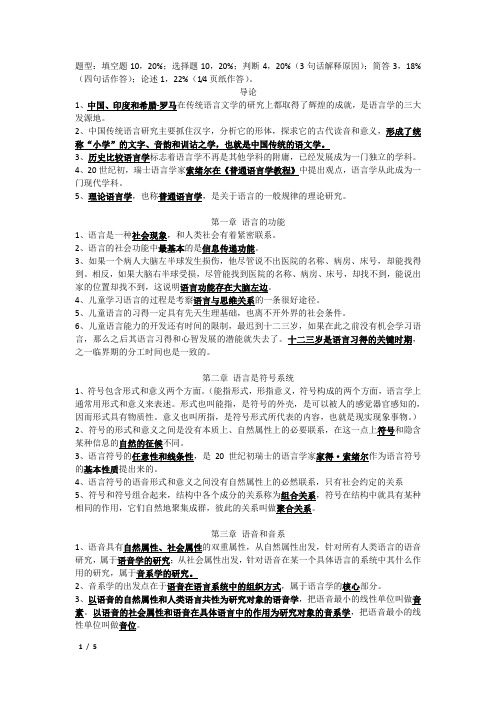
题型:填空题10,20%;选择题10,20%;判断4,20%(3句话解释原因);简答3,18%(四句话作答);论述1,22%(1/4页纸作答)。
导论1、中国、印度和希腊-罗马在传统语言文学的研究上都取得了辉煌的成就,是语言学的三大发源地。
2、中国传统语言研究主要抓住汉字,分析它的形体,探求它的古代读音和意义,形成了统称“小学”的文字、音韵和训诂之学,也就是中国传统的语文学。
3、历史比较语言学标志着语言学不再是其他学科的附庸,已经发展成为一门独立的学科。
4、20世纪初,瑞士语言学家索绪尔在《普通语言学教程》中提出观点,语言学从此成为一门现代学科。
5、理论语言学,也称普通语言学,是关于语言的一般规律的理论研究。
第一章语言的功能1、语言是一种社会现象,和人类社会有着紧密联系。
2、语言的社会功能中最基本的是信息传递功能。
3、如果一个病人大脑左半球发生损伤,他尽管说不出医院的名称、病房、床号,却能找得到。
相反,如果大脑右半球受损,尽管能找到医院的名称、病房、床号,却找不到,能说出家的位置却找不到,这说明语言功能存在大脑左边。
4、儿童学习语言的过程是考察语言与思维关系的一条很好途径。
5、儿童语言的习得一定具有先天生理基础,也离不开外界的社会条件。
6、儿童语言能力的开发还有时间的限制,最迟到十二三岁,如果在此之前没有机会学习语言,那么之后其语言习得和心智发展的潜能就失去了。
十二三岁是语言习得的关键时期,之一临界期的分工时间也是一致的。
第二章语言是符号系统1、符号包含形式和意义两个方面。
(能指形式,形指意义,符号构成的两个方面,语言学上通常用形式和意义来表述。
形式也叫能指,是符号的外壳,是可以被人的感觉器官感知的,因而形式具有物质性。
意义也叫所指,是符号形式所代表的内容,也就是现实现象事物。
)2、符号的形式和意义之间是没有本质上、自然属性上的必要联系,在这一点上符号和隐含某种信息的自然的征候不同。
3、语言符号的任意性和线条性,是20世纪初瑞士的语言学家家得·索绪尔作为语言符号的基本性质提出来的。
语言学考试题库及答案
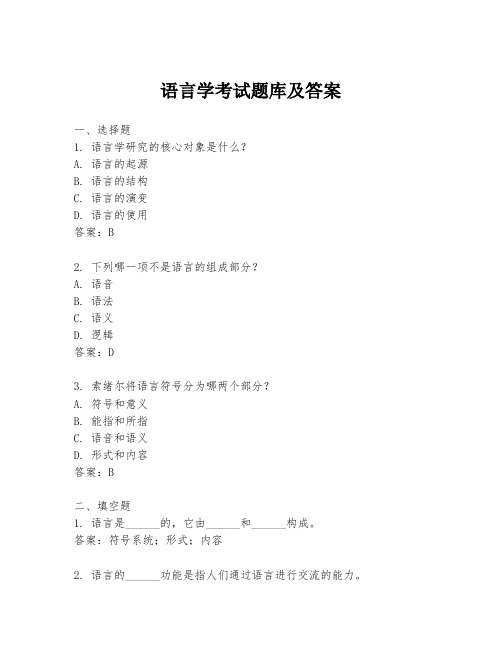
语言学考试题库及答案一、选择题1. 语言学研究的核心对象是什么?A. 语言的起源B. 语言的结构C. 语言的演变D. 语言的使用答案:B2. 下列哪一项不是语言的组成部分?A. 语音B. 语法C. 语义D. 逻辑答案:D3. 索绪尔将语言符号分为哪两个部分?A. 符号和意义B. 能指和所指C. 语音和语义D. 形式和内容答案:B二、填空题1. 语言是______的,它由______和______构成。
答案:符号系统;形式;内容2. 语言的______功能是指人们通过语言进行交流的能力。
答案:交流3. 语言的______功能是指语言能够表达思想和情感的能力。
答案:表达三、简答题1. 简述语言和言语的区别。
答案:语言是指一种抽象的符号系统,它包括语音、语法、语义等规则和结构;言语则是指个人使用语言进行交流的具体行为。
2. 描述索绪尔的“能指”和“所指”概念。
答案:索绪尔认为语言符号由“能指”和“所指”两部分组成。
“能指”指的是语言符号的声音形式,而“所指”指的是符号所代表的概念或意义。
四、论述题1. 论述语言的任意性原则及其对语言学习和教学的影响。
答案:语言的任意性原则指的是语言符号的声音形式和它所代表的概念之间没有必然的联系。
这一原则对语言学习和教学有着深远的影响,因为它意味着学习者需要记忆每个符号的声音和意义之间的联系,而不能依赖于逻辑或直观的关联。
这对语言教学提出了挑战,要求教师设计有效的教学方法来帮助学生记忆和理解这些任意的联系。
2. 分析语言的交际功能及其在现代社会中的重要性。
答案:语言的交际功能是指语言作为交流工具,使人们能够传递信息、表达情感和进行社会互动。
在现代社会,随着全球化和信息技术的发展,语言的交际功能变得尤为重要。
有效的沟通能够促进国际合作、文化交流和商业交易,同时也有助于解决社会冲突和增进理解。
因此,掌握一门或多门语言对于个人和社会的发展至关重要。
语言学纲要期末复习资料(题库)
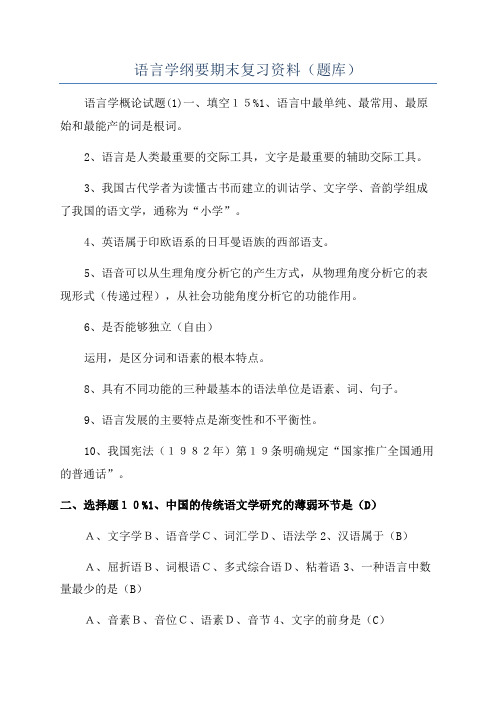
语言学纲要期末复习资料(题库)语言学概论试题(1)一、填空15%1、语言中最单纯、最常用、最原始和最能产的词是根词。
2、语言是人类最重要的交际工具,文字是最重要的辅助交际工具。
3、我国古代学者为读懂古书而建立的训诂学、文字学、音韵学组成了我国的语文学,通称为“小学”。
4、英语属于印欧语系的日耳曼语族的西部语支。
5、语音可以从生理角度分析它的产生方式,从物理角度分析它的表现形式(传递过程),从社会功能角度分析它的功能作用。
6、是否能够独立(自由)运用,是区分词和语素的根本特点。
8、具有不同功能的三种最基本的语法单位是语素、词、句子。
9、语言发展的主要特点是渐变性和不平衡性。
10、我国宪法(1982年)第19条明确规定“国家推广全国通用的普通话”。
二、选择题10%1、中国的传统语文学研究的薄弱环节是(D)A、文字学B、语音学C、词汇学D、语法学2、汉语属于(B)A、屈折语B、词根语C、多式综合语D、粘着语3、一种语言中数量最少的是(B)A、音素B、音位C、语素D、音节4、文字的前身是(C)A、结绳记事B、手势C、图画记事D、实物记事5、派生词中包含(B)A、词尾B、词根C、虚词D、根词6、语音和语义结合的最小的语言单位是(C)A、音素B、义素C、语素D、音位7、汉语单词“忽然”出现的位置是(C)A、主语位置B、谓语位置C、状语位置D、定语位置8、以下各种语言变体中,属于社会方言的是(D)A、土话B、客家话C、客套话D、黑话9、下列语素中属于自由语素的是(C)A、初B、视C、人D、民10、在语言结构的某一环节上能够互相替换,具有某种相同作用的各个单位之间所形成的关系叫(D)A、转换关系B、组合关系C、层级关系D、聚合关系三、名词解释20%1、专语语言学:以具体语言作为研究对象的语言学。
2、组合关系:指两个以上相连续的语言符号组合而成的线性关系。
3、语流音变:语流中的某些音由于相互影响而发生临时性的变化,这种变化就叫语流音变。
语言学概论复习资料(全)
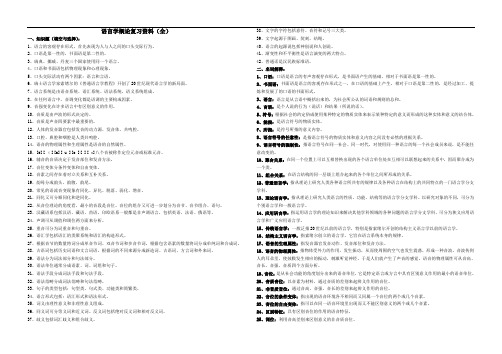
语言学概论复习资料(全)一、知识题(填空与选择):1、语言的客观存在形式,首先表现为人与人之间的口头交际行为。
2、口语是第一性的,书面语是第二性的。
3、瑞典、挪威、丹麦三个国家使用同一个语言。
4、口语和书面语包括物理现象和心理现象。
5、口头交际活动有两个因素:语言和言语。
6、瑞士语言学家索绪尔的《普通语言学教程》开创了20世纪现代语言学的新局面。
7、语言系统是由语音系统、语汇系统、语法系统、语义系统组成。
8、在任何语言中,音调变化都是语调的主要构成因素。
9、音强变化在许多语言中有区别意义的作用。
10、音质是由声波的形式决定的。
11、音质是声音四要素中最重要的。
12、人体的发音器官包括发音的动力源、发音体、共鸣腔。
13、口腔、鼻腔和咽腔是人类共鸣腔。
14、语音的物理属性和生理属性是语音的自然属性。
15、[e][ ε][a][ u ][o ][ ][ ɑ]八个音被称作定位元音或标准元音。
16、辅音的音质决定于发音部位和发音方法。
17、音位变体分条件变体和自由变体。
18、音素之间存在着对立关系和互补关系。
19、韵母分成韵头、韵腹、韵尾。
20、常见的语流音变现象有同化、异化、脱落、弱化、增音。
21、同化又可分顺同化和逆同化。
22、从音位理论的角度看,最小的音段是音位。
音位的组合又可进一步划分为音节、音节组合、语句。
23、汉藏语系包括汉语、藏语、苗语。
印欧语系一般都是非声调语言,包括英语、法语、俄语等。
24、声调可从调值和调位两方面来分析。
25、重音可分为词重音和句重音。
26、语汇学包括语汇的类聚系统和语汇的构造形式。
27、根据音节的数量将词分成单音节词、双音节词和多音节词。
根据包含语素的数量将词分成单纯词和合成词。
28、古语词包括历史词语和文言词语。
根据词的不同来源分成新造词、古语词、方言词和外来词。
29、语法分为词法部分和句法部分。
30、语法单位通常分成语素、词、词组和句子。
31、语法手段分成词法手段和句法手段。
语言学复习资料

语言学概论复习提纲一、名词解释1、义丛:是指由一般短语表示的语义单位,是由若干义项组合而成的。
如“烤羊肉串”,一是指把羊肉串烤熟,二是指烤熟的羊肉串。
2、义素:是构成义项的语义成分,是一组相关的词语中抽象出来的区别性语义特征,又叫语义成分、语义特征、语义标示、语义原子等。
是指通过对一组相关词语的比较二分析出来的相互区别的语义特征,如“男人”的三个义素,就是通过“男人”与“女人”、“男孩”、“女孩”相互区别的语义特征。
3、语义指向:是句子中词语之间的语义关系,包括连续成分和非连续成分之间的语义关系。
如“他一向性格开朗。
”“性格”与“开朗”有事物一性状关系,“性格”与“他”也有领属关系,所以,“性格”的语义既指向“开朗”也指向“他”。
4、语法范畴:广义语法范畴是各种语法形式表示的语法意义的概括。
狭义语法范畴是由词的形态变化表示的语法意义的概括,又称形态范畴。
5、表述:是指由句子表示的语义单位,也叫句义。
一个句子表示一种意义就是一个表述。
6、专门意义:反映具备某种专门知识的人对所指对象的特殊认识,往往反映事物内在的本质特征,比较深刻、明确。
如具备光学知识的人知道“红”、“蓝”的光学特征不同。
7、时:是指说话时间、事件时间和参照时间三者之间的相互关系。
8、语段:是由语义上相互联系的若干句子,围绕一个语义中心组织起来的句子组合,又称句群、句组、句段、语篇、篇章、超句体等。
9、语义场:若干具有共同核心义素的词语(以义项为单位)构成的聚合体,就是语义场。
10、语流音变:说话时音位和音位之间能够互相影响而使前音或后音发生某种临时性的变化,这种变化发生在语流中,所以叫“语流音变”。
语音流变包括:同化、异化、弱化、加音、脱落、换位。
11、同现:是指某些词语与另外一些词语经常在话语中同时出现,主要包括有类义(包括反义)关系或联想关系的词语。
12、同指:是指语段中不同的句子包含所指相同或基本相同的词语,是语段中的一种重要关联手段。
语言学概论考试复习资料

语言学概论第一章:1、what is language?A:Language is a system of arbitray vocal symbols by means of which the member of a speech community communicate ,interact and transmit their culture.It is social and conventional in that language is a social semiotic and communication can only take place effectively if all the useres share a broad understanding of human interaction .2、Design features of language?(1)Arbitrarine: The fact that the forms of linguistic signs bear no natural relationship to theirmeaning .However there seem to be different levels of Arbitriness.Arbitrary relationship between the sound of a morpheme and its meaning. B: Arbitrariness at the syntactic level: C:Arbitrariness and convention: Arbitrariness of language makes it potentially creative ,and conwentionality of language makes learning a language laborious.(2)Duality二元性: “By DUALITY is meant the property of having two levels of structures ,suchthat units of the primary level are composed of elements of the secondary level and each of the two levels has its own ptinciples of organization.”By CREATIVITY we means language is resourceful because of its duality and its recursivveness .(3)Displacement替代性:DISPLACEMENT means that human language enable their users tosymbolize objects,events and concepts which are not present in time and space at the moment of conmmunicationPhonetics and Phonology :It is generally agreed that linguistics should at least five parameters, namely ,phonological, morphological,syntactic,semantical and pragmatic.Phonetics:PHONETICS studies speech sounds,including the production of speech ,that is how speech sounds are actually made,transmitted and received,the description and classification of speech sounds,words and connected speech,etc.Phonology:PHONOLOGY studies the rules governing the structure,distribution,and sequencing of speech sounds and the shape of syllables.3、Descriptive描写的vs.Prescriptive规定的The distinction lies in prescribing how things ought to be and describing how things are.”ere are obvious administrative and education advantages,in the modern world,in standardizing the principal dialect that is employed within a particular country or region .”But the nature of linguistics as a science determines its preoccupation with descpiption instead of prescription. SYNCHRONIC限于一时description takes a fixed instant as its point of observation .However ,the fiction of synchronic description is essencial to linguistics.DIACHRONIC历时linguistics is the study of a language through the course of its history.4、Language &ParoleSaussure distinguished the linguistic competence of the speaker and the actual phenomena or data of linguistics as LANGUE and PAROLE. While parole constitutes the immediately accessible date,the lingustic ‘s proper object is the langue of each community,the lexicon.grammar,and phonogy implanted in each individual by his upbring in society and on the basis of which he speaks and understand his language.Competence: A language user’s underlying knowledge about the system of rules. Performance: refers to the actual use of language in concrete situations.第二章Consonants辅音:are produced by constricting or obstructing the vocal tract at some place to divert, impede, or completely shut off the flow of air in the oral cavity.Vowels元音:are produced without such obstruction so no turbulence or a total stopping of the air can be perceived.Cardinal vowels are a set of vowel qualities arbitrarily defined, fixed and unchanging, intended to provide a frame of reference for the description of the actual vowels of existing languages.Eight primary cardinal vowels are:[i][e][ ][ ][ ][ ][ ][ ]Phonemes音素:refers to a “unit of explicit sound contrast”:the existence of a minimal pair automatically grants phonemic status to sounds responsible for the contrasts.例/p/、/l/ Allophony: the phenomenon of variation in the pronunciation of phonemes in different positions.例[p=,p h]belong to /p/;[l,]belong to /l/. peak,speak;lead,deal.Assimilation同化: nasalization, dentalization, and velarization are all instances of assimilation, a process by which one sound takes on some or all the characteristics of a neighboring sound. Regressive回归assimilation: a following sound is influencing a preceding soundProgressive进步assimilation: a preceding sound is influencing a following sound.第三章Morpheme词素: the smallest unit of language in terms of relationship between expression and content, a unit that cannot be divided into further smaller units without destroying or drastically altering the meaning, whether it is lexical or grammatical.Inflection变音: is the manifestation of grammatical relationships through the addition of inflectional affixes, such as number, person, finiteness, aspect and case, which do not change the grammatical class of the stems to which they are attached.Word-formation: process of word variations signaling lexical relationships. Including compound and derivation.第四章:1、SYNTAX句法is the study of the rules governing the ways different constituents are combined to form sentences in a language ,or the study of the interrelationships between elements in sentence structures.Syntactic relation can be analysed into three kinds:positional relations, relations of substitutability,and relations of co-occurrence.Position Relation ,or word order to the sequential arrangement of the words in a language .If the words in a sentence fail to occur in a fixed order required by the convention of a language ,one tends to produce an utterance either ungrammatical or nonsensical at all.Relation of StustitutabilityFirstly ,the Relation of Stustitutability refers to classes or sets of words substitutable for each other grammatically in sentences with the same structure. Secondly,it refers to groups of one word which may be jointly substitutable grammatically for a single word of a particular set.By the Relation of Co-occurrence one means that words of different sets of clauses maypermit ,or require ,the occurrence of a word of another set or class to form a sentence or a particular part of a sentence.第五章:1、Meaning of “MEANING”:7 types of meaning:(1)Conceptual meaning (2)Connoative meaning (3)Social meaning (4)Affective meaning (5)Reflected meaning (6)Collocative meaning (7)Thematic meaning2、Sence RalationsWords are in different sence relation with each other .There are three kinds of sense relation recognized ,namely ,sameness relation,oppositenness and inclusiveness relation.(1)Synonymy同义:SYNONYMY is the technique name for the sameness relation.English is saidto be rich in synonys.Its vocabulary has two sources :Anglo-Saxon and Latin. But to synonymy is rare.The synonyms are all context dependent. Thirdly,there are dialectal differences.(2)Autonymy反义:is the name of for oppositeness relation.There are 3main sub-types:gradableantonymy,complementary antonymy,and converse antonymy.A:Gradable antonymy:First,as the name suggest,they are gradable.Scond,antonymy of this kind are graded againsr different norms. Third,one member of a pair,usually the term for the higher degree,serves as the cover term.B:Comlementary antonymy:In constrast to the first typr,the members of a pair in this type are complementary to each other.That is ,they divided up the whole of a semantic field completely.(3)Hyponymy上下位关系: the term HYPOYMY is of recent creation,which has not found its way to some small dictionaries yet.But the notion of meaning inclusiveness is not new.第八章Cp: cooperative principle. Make your conversational contribution such as is required, at the stage at which it occurs, by the accepted purpose of direction of the talk exchange in which you are engaged.Characteristics of implicature: 1)calculability: the fact that speakers try to convey conversational implicatures and hearers are able to understand them suggests that implicatures.2)cancellability: also defeasibility. 3)non-detachability: a conversational implicature is attached to the semantic content of what is said, not to the linguistic form. 4)non-conventionality:Conversational implicature: a type of implied meaning, which is deduced on the basis of the conventional meaning of words together with the context, under the guidance of the CP and its maxims.语言学与英语学习的关系:Linguisics helps you understand how languages work from biological, social, cultural and psychological perspectives. If you enter this field, you can either pursue academic research about a language, or become a very acomplished english teacher.。
语言学概论期末考试复习题及参考答案

语言学概论(八)期末考试复习题及参考答案一、单选题1.(2分)语言符号的任意性是指A.语言符号可以任意使用和创造B.绝大多数语言符号的能指和所指之间没有必然的理据关系C,可以任意使用语言符号绐事物命名D∙语言符号的能指和所指可以任意改变参考答案:B2.(2分)下列各组辅音中,发音部位相同的•组是A.image1..pngB.image2.pngC.image3.pngD.Image4.png参考答案:B3.(2分)“汽车”和“轿车”是A.上下位词B.同义词C.等义词D.近义词参考答案,A4.(2分)下列几种社会方言中,具有排他性的一项是A.阶级习惯语B.行话C隐语D.学生腔参考答案:C5.(2分)下列关于亲属语言的表述中,不正确的项是A亲属语言是社会完全分化的产物B∙亲属语言之间具有历史同源关系C.语言亲属关系有亲疏远近的分别D.亲属语言间不存在语音对应关系参考答案:D6..(2分)“老郎鼓励我考大学”是A.生谓诃组B.兼语词组C.连动词组D.复句词组参考答案,B7.12分)目前己知的最古老的拼音文字是一A.古埃及文字8.占希腊文字C腓尼基文字D∙中国的甲骨文参考答案:C9.(2分)划分词类的最本质的标准是A.分布标准8.意义标准C.形态标准D逻辑标准参考答案,A9.(2分)外语学习中的后期阶段被称为A.中介语阶段B.目标语阶段C低平期D高原期参考答案I D10.(2分)英语“students"中的"∙s"是.A.虚词语素B∙词根语素C.构形语素D.构词语素参考答案:C11.(2分)认为“思维和语言各自发展,二者没仃关系”的学者不包括A.古希腊哲学家柏拉图B.法国哲学家迪卡尔C.英国哲学家座布斯D.苏联语言学家马尔参考答案:D12.(2分)以卜.不属于语言学的三大发源地的是A.中国B.埃及C.印度D希腊•罗马参考答案,B13.(2分)下列语言学流派中桀中研究语言本体的流派是A.功能语言学B∙社会语言学C认知语言学D.结构语言学春考答案:D14.(2分)下面词组中,结构类型与其他各组不同的•组是A.年轻漂亮/朴素大方B.我们大家/首都北京C.民航大厦/工人农民D.贯彻执行/讨论研究辨考答案:C15.(2分)关于语言获得的原因,卜列学说中偏重于内部条件解择的一项是A.天赋说B.摹仿说C强化说D剌激反应说参考答案;A16.(2分)传统上把汉字的单纯字符称为A偏旁B笔画C记号D.独体字参考答案,D17.(2分)北京话“面”单念时读作但“面包”却读作[mi?mpau),这种语流音变现象是A溺化B.增音C同化D.异化春考答案:C18.(2分)汉语中的词类(词的语法分类)可以首先分出的两个大类是一A.基本词和非基本词B.实诃和虚词C.典型词和兼类词D.体词和谓词参考答案:B19.(2分)目前对于语言和思维的关系,比较一致的观点是A.有什么样的思维,就有什么样的语言B∙有什么样的语言,就有什么样的思维C思维对语言有•定影响,但更重要的是语言决定思维D.语言对思维有一定影响,但更重要的是思维决定语言参考答案,D20.(2分)听觉上最自然、最容易分辨的最小语音单位是A.音素B.国i音C音位D.音节参考答案:D21.(2分)首先提出“能指”和“所指”这对概念的语言学家是A洪堡特B.索绪尔D.萨丕尔分考答案:B22.(2分)判断两种话是不同语言还是同一种语言的不同方言应该主要参考A.相互理解程度B.语言结构的差异程度C.共同的历史文化传统和民族认同感D∙地域临近程度参考答案,C23.(2分)语言符号具有可变性的根本原因在丁语言符号的A.任意性B.强制性C离散性D.系统性参考答案:A24.(2分)下列各项中,谓词和变元之间属于动作与结果关系的是A.写黑板B.打篮球C.织毛衣D.寄包裹参考答案,C25.(2分)从词的构造类型上看,汉语“动人”一词属于A.单纯词B.复合词D.简缩词参考答案:B26.(2分)语法的演变之所以比语汇缓慢,是因为A语法规则比较简单B.语法规则数量较少C.语法规则具有强制性D∙语法规则具有抽象性参考答案IC27.(2分)构形语素属于A.虚词语素B.词根语素C.自由语素D.黏若语素参考答案:D28.(2分)下列各组中,三个复合词构词类型不一致的一组是A.席卷耳鸣地震B.打倒切断推翻C发光散热出气D.天地欢乐爱好弁考答案:A29.(2分)在语言谱系分类的层级体系中,域大的类别是一A.语族B.语支C.语系D∙语群参考答案,C30.(2分)从语音的社公功能角度划分出来的最小语音单位是A.音位B.音素C.音节D.各渡参考答案:B31.(2分)人类语言和动物的交际方式A.完全一致B.有根本区别C有•定的差别D∙基本一样参考答案:B32.(2分)“我知道你很聪明。
语言学复习资料附答案(完整)

语言学复习资料附答案(完整)语法范畴:词形变化表现的语法意义的聚合叫做“语法范畴”。
语法范畴就是词形变化所表达的语法意义的类。
常见的语法范畴主要性、数、格、体、时、态、级等,俄语、德语、法语中的某些词有性的区分。
文字:是指语言的视觉符号性质,是为了记录语言而发明的一种书写符号系统,是在语言的基础上产生的。
文字有音,形,义三部分。
音位变体:处在互补关系中的相似的音素彼此不对立,即不起区别词的语音形式的作用,我们可以把它们归并为一个音位。
如果他们被归为一个音位,则处于互补关系中的各个音素就被看作同一个音位在不同的位置上的代表,是同一个音位的不同的变异形式,所以我么把它们叫做音位变体。
音位变体可以分为“自由变体”和“条件变体”组合关系:符号和符合组合起来,形成高一级的结构,处于高一级结构中的各个符号,称为结构的成份,结构中的各个成分的关系称为组合关系。
聚合关系:如果一些语言符号或更大的单位在结合的某一环节上能够互相替换并且替换后结构关系不会改变,那么这些符号在结构中就具有某种相同的作用,它们自然地聚集成群,它们彼此的关系叫做聚合关系。
直接组成成分:句子是按照一定的规则一层一层组合起来的。
每一层中直接组合起来构成一个更大的语法单位的两个组成成分叫做直接组成部分。
洋泾浜:是当地人在和外来的商人,水手,传教士等打交道的过程中学来的一种变了形的外语。
是当地人没有学好的外语,是外语在当地语言的影响下出现的变种。
“洋泾浜”的共同特点是:语音经过当地语言音系的适当改造,语法规则减少到最低限度,词汇的项目比较少,往往要借助于迂回曲折的总说法指称事物。
“洋泾浜”是一定社会条件下的产物,只有口头形式,用于和外国人交往的特殊场合,没有人把它看作母语作为第一语言。
语言和言语语言的交际功能就是通过言语形式来实现的。
语言学中把对语言的运用及其成果成为言语,通俗点讲言语就是说话(或写作)和所说(所写)的话语言是从言语中概括出来的的为社会所公认的词语和规则的总和。
语言学复习资料
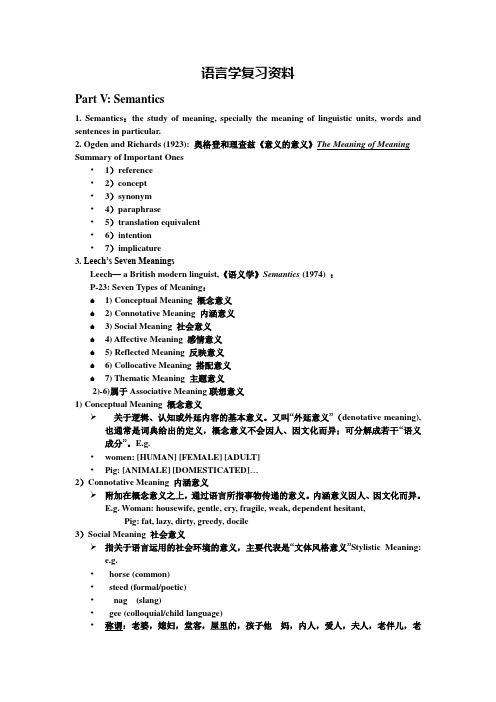
语言学复习资料Part V: Semantics1. Semantics:the study of meaning, specially the meaning of linguistic units, words and sentences in particular.2. Ogden and Richards (1923): 奥格登和理查兹《意义的意义》The Meaning of Meaning Summary of Important Ones•1)reference•2)concept•3)synonym•4)paraphrase•5)translation equivalent•6)intention•7)implicature3. Leech’s Seven MeaningsLeech— a British modern linguist,《语义学》Semantics (1974) :P-23: Seven Types of Meaning:♠1) Conceptual Meaning 概念意义♠2) Connotative Meaning 内涵意义♠3) Social Meaning 社会意义♠4) Affective Meaning 感情意义♠5) Reflected Meaning 反映意义♠6) Collocative Meaning 搭配意义♠7) Thematic Meaning 主题意义2)-6)属于Associative Meaning联想意义1) Conceptual Meaning 概念意义➢关于逻辑、认知或外延内容的基本意义。
又叫“外延意义”(denotative meaning),也通常是词典给出的定义,概念意义不会因人、因文化而异;可分解成若干“语义成分”。
E.g.•women: [HUMAN] [FEMALE] [ADULT]•Pig: [ANIMALE] [DOMESTICATED]…2)Connotative Meaning 内涵意义➢附加在概念意义之上,通过语言所指事物传递的意义。
语言学-期末考试-复习材料

语言学-期末考试-复习材料一、选择(20个)二、判断(10~20个)三、填空(5分)四、词语解释(3个,各5分)五、简答(2个,各10分;其中一个是语用学)六、句子分析(4个)IC analysis 是倒着的树形图Chomsky 是有S, NP,VP…与其中的树形图。
1. Phonetics & Language Introduction:1. There is no logical connection between meaning and sounds. A dog might be a pig if only the first person or group of persons had used it for a pig. This is __B____one of the design features of language.A. dualityB. arbitrarinessC. productivityD. displacement2. Language is a system of two sets of structures, one of sounds and the other of meaning. This is __B__ . It makes people possible to talk everything within his knowledge.A. dualityB. arbitrarinessC. productivityD. displacement3. __C___ refers to the ability to construct and understand an indefinitely large number of sentences in one?s native language, including those that he has never heard before, but that are appropriate to the speaking situation.A. dualityB. arbitrarinessC. productivityD. displacement4. ___D__ refers to the fact that one can talk about things that are not present, as easily as he does things present. The dog couldn?t be bow-wowing sorrowfully for some lost love or a bone to be lost.A. dualityB. arbitrarinessC. productivityD. displacement5. ___D___ means language is not biologically transmitted from generation to generation, but the linguistic system must be learnt anew by each speaker.A. dualityB. ArbitrarinessC. interchangeabilityD. cultural transmission6. ___C___ means that any human being can be both a producer and a receiver of messages.A. dualityB. ArbitrarinessC. interchangeabilityD. cultural transmission7. To say “How are you. ”“Hi”to your friends is the ___C____of language.A. directive functionB. informative functionC. phatic function (adj. 交流感情/交际应酬的)D. interrogative function8. “Tell me the result when you finish.”If you want to get your hearer to do something, you should use the ___B__ function of language.A. directive functionB. informative functionC. phatic functionD. interrogative function9. A linguist regards the changes in language and language use as _____.A. unnaturalB. something to be fearedC. natural C. abnormal10. A linguist is interested in _______.A. speech sounds onlyB. all soundsC. vowels only C. consonants only11. Which of the following sounds is a voiceless bilabial stop?A. [t]B. [m]C. [b]D. [p]12. Which of the following sounds is a voiced affricate?A. [y]B. [t∫]C. [z]D. [dЗ]13. Which of the following sounds is a central vowel?A. [ ? ]B. [ i ]D. [a: ]14. In the following sounds , ______ is a palatal fricative ?A. [ s ]B. [∫]C. [ l ]D. [θ]15. In the following sounds , ______ is a voiceless affricative ?A. [dЗ]B. [ v ]C. [t∫]D. [θ]16. In English if a word begins with a [ l ] or [ r ],then the next sound must be a ____.A. fricativeB. nasal soundC. semi-vowelD. vowel17. Of the “words”listed below, _____ is not an English word ?A. [r∧b ]B. [ l? b ]C. [m?sta:∫]D. [lm?p]18. _____ are produced when the obstruction created by the speech organs is total and audibly released.A. Back vowelsB. StopsC. Fricatives C. Glides19. The International Phonetic Association devised the INTERNATIONAL PHONETIC ALPHABET in ______.B. 1957C. 1888D. 178820. ____ is a phonological unit , and it is a unit that is of distinctive value.A. PhoneB. PhonemeC. AllophoneD. SoundII. Tell which statements are true or false.1. [ f ] is a dental consonant.2. Phonology studies the characteristics of speech sounds and provides methodsfor their description, classification and transcription.3. Phoneme is a phonological unit.4. Phone is a phonetic unit.5. When we study the different [ p ]’s in “[ pit ], [tip ], [spit ]”, they are similarphones which belong to phonetics.6. But the three [ p ] belong to the different phoneme / p /.7. The three / p / are allophones.8. ‘peak’is aspirated , phonetically transcribed as [ph]; ‘speak’isunaspirated (不送气的)phonetically[ p=].9. [ph ], [p=] do not belong to the same phoneme / p /.10. [p h] and [ p=] are two different phones, and are variants of the phoneme / p /,which is called ALLOPHONES of the same phoneme.key: BACDD CCACA DDABC DDBCB FFTTT FTTFTI. Choose the best choice(语音)1. Which is a voiced bilabial stop?A. [m]B. [v]C. [p]D. [b]2. Which is a voiceless affricate?A. [w]B. [f]C. [t∫]D. [n]3. Which is monophothong?A. [i]B. [au]C. [ai]D. [ei]4. Which is a voiceless bilabial stop?A. [p]B. [m]C. [b]D. [t]5. Which is a voiced affricate?A. [j]B. [z]C. [t∫]D. [dЗ]6. Which is a central vowel ?A. [i]B. [?:]C. [ou]D. [a:]7. In English if a word begins with [l] or [r] , then the next sound must be a ____.A. fricativeB. nasal soundC. semi-vowelD. vowel8. Which is a palatal fricative?A. [s]B. [k]C. [∫]D. [l]9. Which is not a English word?A. [r ?b]B. [l?b]C. [sta:∫]D. [ lm?p]10. Which is a unaspirate?A. skyB. killC. likeD. kite2. Semantics 练习1._______ is not included in Leech?s associative meaning.A. Connotative meaningB. Social meaningC. Collocative meaningD. Thematic meaning2. Among Leech?s seven types of meaning is concerned with the relationship betweena word and the thing it refers to _______.A. conceptualB. affectiveC. reflectedD. thematic3. According to the referential theory, a word is not directly related to the thing it refers to. They are connected by ______.A. meaningB. referenceC. conceptD. sense4.”Big” and “Small” are a pair of ______ opposites.A. complementaryB. gradableC. completeD. Converse5. The pair of words “lend” and “borrow” are ______.A. gradable opposites B, converse opposites C. co-hyponymsD. synonyms6. A word with several meaning is called ______ word.A. a polysemousB. a synonymousC. an abnormalD. a multiple7. The semantic compone nts of the word “gentleman” can be expressed as ___.A. +animate, +male, +human, -adultB. +animate, +male, +human, +adultA. +animate, -male, +human, -adult D. + animate, -male, +human, +adult8. _____ is a phrase which can only be understood as a unit, not as a summation of themeaning of each constituent word.A. CollocationB. IdiomC. Semantic componentD. Synonym9. In the triangle advanced by Ogden and Richards, “thought or reference” is____A. word, sentenceB. the objectC. conceptD. symbol10. A linguistic is interested in _____.A. What is said.B. What is right both in syntax and in semantics.C. What is grammaticalD. What ought to be said.11. The pair of words “lend” and “borrow” are _____.A. gradable oppositesB. relational oppositesC. synonymsD. co-hyponyms12. Nouns, verbs, and adjectives can be classified as _____.A. Lexical wordsB. grammatical wordsC. function wordsD. form words13. What is t he meaning relationship between the two words “flower/tulip” ?A. PolysemyB. HomonymyC. HyponymyD. Antonymy14. The words “railway” and “railroad” are _____.A. synonyms differing in emotive meaningB. dialectal synonymsC. collocationally-restricted synonymsD. synomyms differing in styles15. The pair of words “wide/narrow” are called____.A. gradable oppositesB. complementary antonymsC. co-hyponymsD. relational opposites16. Which of the following two-term sets shows the feature of complementaries?A. single/marriesB. lend/borrowC. hot/coldD. old/youngDACBB _BBBB BACBA AII. Answer the questions with “Yes”or “No” .1.Is reference tied to a particular time and place? Y2.Every word in a language can find at least one referent in the objective world. ?N3.Can different expressions have the same referent? Y4.Can reference be applied to words such as “and” ,”very” in English? NIII.State the following sentences “True” or “False”.1. Sense is regarded as a kind of intra-linguistic relationship. T2. In most cases, “sense” and “meaning” are different terms for the same thing. T3. Every word has its own sense. F4. A word may have several different senses and several words may have the samesense. T5. Extension, like denotation, is a kind of relation between elements and theobjective world. T6. Extension can only be applied to the things at present. F7. The relation between extension and intension is the same as that betweendenotation and sense. T8. People of different cultures may choose different prototype for the same predicate,e.g. …bus?. T9. All the words in a language can be used to refer , but only some have sense. F10. Two synonymous words must be identical in sense in every dimension. F11. There are very few perfect synonyms in a language. T12. Entailment is more inclusive than paraphrase. T13. Almost every word in a dictionary is polysemic. T14. Dry and wet are a pair of gradable antonyms. T15. Innocent and guilt are a pair of relative antonyms. F Complementary16. The relationship between the Argument and Predicate is Subject to predicate.F17. The meaning of each expression can be defined in terms of its semanticcomponents so as to contrast with the meaning of all the expressions in the same language. T18. The proposition of a sentence may be more simply stated as a verb and a selection of case ---categories. T19. According to case grammar, the part of proposition in a sentence is a tensed set of relationships between a verb and a noun phrase ( or noun phrases).4. Exercises to Chapter 4 SyntaxI. General view of syntax1. Syntax: studies the rules governing the way words are combined to form sentences.2. gender: as masculine, feminine, neuter, or animate, and inanimate.3. case: the syntaxtic relationship between words. Teacher?s , kiss him宾格,主格,与格,芬兰语有15种格4.Concord: agreement: a syntactic relationship agree with each other.5. Government : A word determines the form of others.支配关系6. langue and paroleLangue: abstract linguistic system shared by all the members of a speechcommunity. StabilityParole: actual speech7. signified (concept) and signifier (sound image)1. 所指 2 能指之间的关系是任意的8. syntagmatic and paradigmatic relationsSyntagmatic: what precedes or follows9. synchronic and diachronic linguistics10. “Rheme” “Theme”负载交际能力最小的是主位。
语言学复习资料
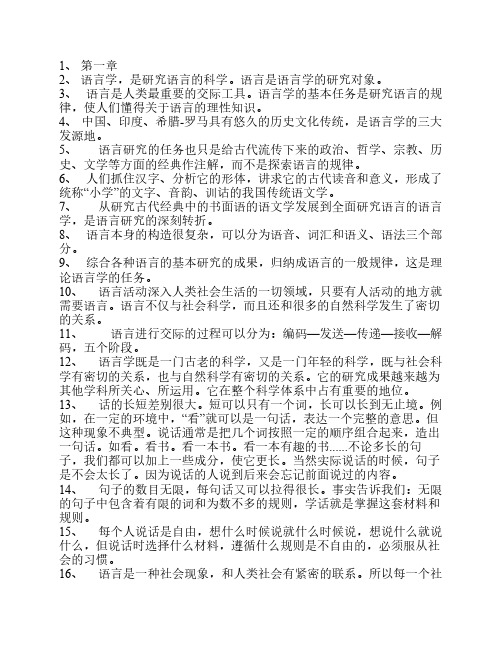
1、第一章2、语言学,是研究语言的科学。
语言是语言学的研究对象。
3、语言是人类最重要的交际工具。
语言学的基本任务是研究语言的规律,使人们懂得关于语言的理性知识。
4、中国、印度、希腊-罗马具有悠久的历史文化传统,是语言学的三大发源地。
5、语言研究的任务也只是给古代流传下来的政治、哲学、宗教、历史、文学等方面的经典作注解,而不是探索语言的规律。
6、人们抓住汉字、分析它的形体,讲求它的古代读音和意义,形成了统称“小学”的文字、音韵、训诂的我国传统语文学。
7、从研究古代经典中的书面语的语文学发展到全面研究语言的语言学,是语言研究的深刻转折。
8、语言本身的构造很复杂,可以分为语音、词汇和语义、语法三个部分。
9、综合各种语言的基本研究的成果,归纳成语言的一般规律,这是理论语言学的任务。
10、语言活动深入人类社会生活的一切领域,只要有人活动的地方就需要语言。
语言不仅与社会科学,而且还和很多的自然科学发生了密切的关系。
11、语言进行交际的过程可以分为:编码—发送—传递—接收—解码,五个阶段。
12、语言学既是一门古老的科学,又是一门年轻的科学,既与社会科学有密切的关系,也与自然科学有密切的关系。
它的研究成果越来越为其他学科所关心、所运用。
它在整个科学体系中占有重要的地位。
13、话的长短差别很大。
短可以只有一个词,长可以长到无止境。
例如,在一定的环境中,“看”就可以是一句话,表达一个完整的意思。
但这种现象不典型。
说话通常是把几个词按照一定的顺序组合起来,造出一句话。
如看。
看书。
看一本书。
看一本有趣的书......不论多长的句子,我们都可以加上一些成分,使它更长。
当然实际说话的时候,句子是不会太长了。
因为说话的人说到后来会忘记前面说过的内容。
14、句子的数目无限,每句话又可以拉得很长。
事实告诉我们:无限的句子中包含着有限的词和为数不多的规则,学话就是掌握这套材料和规则。
15、每个人说话是自由,想什么时候说就什么时候说,想说什么就说什么,但说话时选择什么材料,遵循什么规则是不自由的,必须服从社会的习惯。
语言学-期末复习资料-整理版
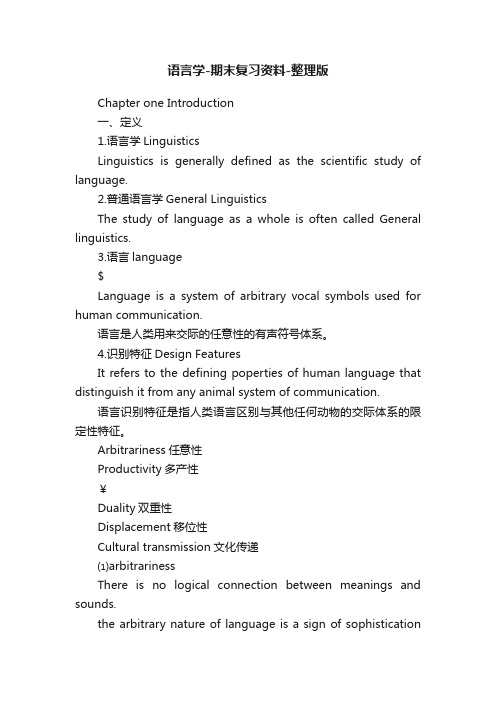
语言学-期末复习资料-整理版Chapter one Introduction一、定义1.语言学LinguisticsLinguistics is generally defined as the scientific study of language.2.普通语言学General LinguisticsThe study of language as a whole is often called General linguistics.3.语言language$Language is a system of arbitrary vocal symbols used for human communication.语言是人类用来交际的任意性的有声符号体系。
4.识别特征Design FeaturesIt refers to the defining poperties of human language that distinguish it from any animal system of communication.语言识别特征是指人类语言区别与其他任何动物的交际体系的限定性特征。
Arbitrariness任意性Productivity多产性¥Duality双重性Displacement移位性Cultural transmission文化传递⑴arbitrarinessThere is no logical connection between meanings and sounds.the arbitrary nature of language is a sign of sophisticationand it makes it possible for language to have an unlimited source of expressions⑵ProductivityAnimals are quite limited in the messages they are able to send."⑶DualityLanguage is a system, which consists of two sets of structures ,or two levels.⑷DisplacementLanguage can be used to refer to contexts removed from the immediate situations of the speaker.⑸Cultural transmissionHuman capacity for language has a genetic basis, but we have to be taught and learned the details of any language system. this showed that language is culturally transmitted. not by instinct. animals are born with the capacity to produce the set of calls peculiar to their species.5.语言能力CompetenceCompetence is the ideal u ser’s knowledge of the rules of his langu age.。
语言学考试复习提纲
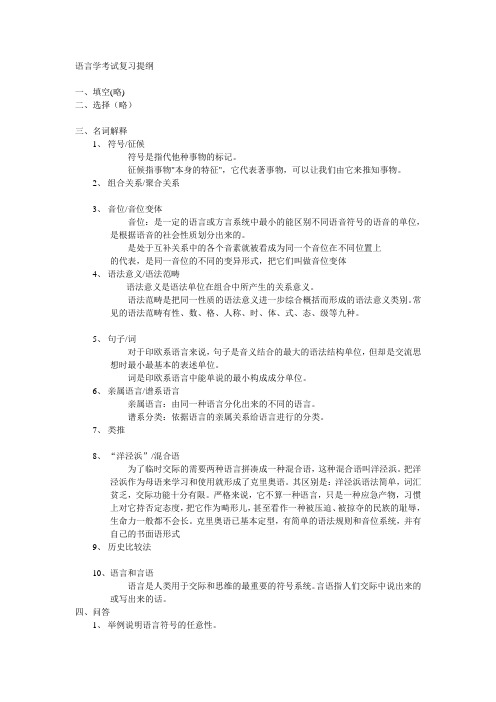
语言学考试复习提纲一、填空(略)二、选择(略)三、名词解释1、符号/征候符号是指代他种事物的标记。
征候指事物"本身的特征",它代表著事物,可以让我们由它来推知事物。
2、组合关系/聚合关系3、音位/音位变体音位:是一定的语言或方言系统中最小的能区别不同语音符号的语音的单位,是根据语音的社会性质划分出来的。
是处于互补关系中的各个音素就被看成为同一个音位在不同位置上的代表,是同一音位的不同的变异形式,把它们叫做音位变体4、语法意义/语法范畴语法意义是语法单位在组合中所产生的关系意义。
语法范畴是把同一性质的语法意义进一步综合概括而形成的语法意义类别。
常见的语法范畴有性、数、格、人称、时、体、式、态、级等九种。
5、句子/词对于印欧系语言来说,句子是音义结合的最大的语法结构单位,但却是交流思想时最小最基本的表述单位。
词是印欧系语言中能单说的最小构成成分单位。
6、亲属语言/谱系语言亲属语言:由同一种语言分化出来的不同的语言。
谱系分类:依据语言的亲属关系给语言进行的分类。
7、类推8、“洋泾浜”/混合语为了临时交际的需要两种语言拼凑成一种混合语,这种混合语叫洋泾浜。
把洋泾浜作为母语来学习和使用就形成了克里奥语。
其区别是:洋泾浜语法简单,词汇贫乏,交际功能十分有限。
严格来说,它不算一种语言,只是一种应急产物,习惯上对它持否定态度,把它作为畸形儿,甚至看作一种被压迫、被掠夺的民族的耻辱,生命力一般都不会长。
克里奥语已基本定型,有简单的语法规则和音位系统,并有自己的书面语形式9、历史比较法10、语言和言语语言是人类用于交际和思维的最重要的符号系统。
言语指人们交际中说出来的或写出来的话。
四、问答1、举例说明语言符号的任意性。
答:语言是一种符号,具有约定性,是用什么样的符号代替什么样的事物,是由使用者共同约定的;又具有任意性,指符号与其所代表的事物之间没有必然的联系。
比如说,汉语普通话说shui,汉语的一些方言说sei、shei、sui、fei,英语说water。
语言学概论复习(完整)
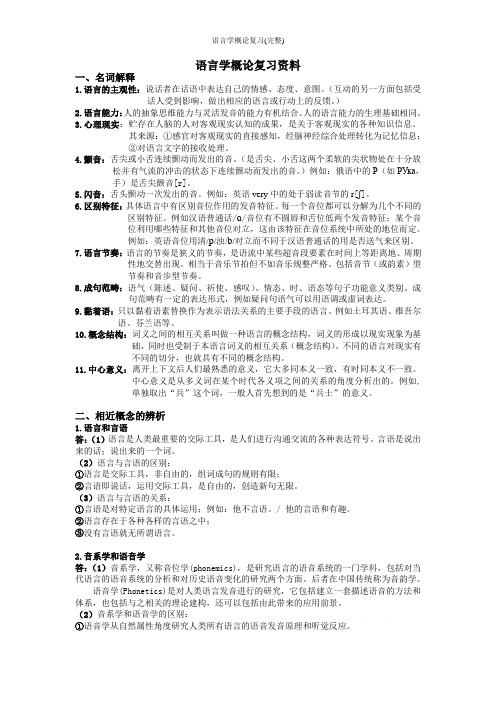
语言学概论复习资料一、名词解释1.语言的主观性:说话者在话语中表达自己的情感、态度、意图。
(互动的另一方面包括受话人受到影响,做出相应的语言或行动上的反馈。
)2.语言能力:人的抽象思维能力与灵活发音的能力有机结合。
人的语言能力的生理基础相同。
3.心理现实:贮存在人脑的人对客观现实认知的成果,是关于客观现实的各种知识信息。
其来源:①感官对客观现实的直接感知,经脑神经综合处理转化为记忆信息;②对语言文字的接收处理。
4.颤音:舌尖或小舌连续颤动而发出的音。
(是舌尖、小舌这两个柔软的尖状物处在十分放松并有气流的冲击的状态下连续颤动而发出的音。
)例如:俄语中的Р(如РУка,手)是舌尖颤音[r]。
5.闪音:舌头颤动一次发出的音。
例如:英语very中的处于弱读音节的r[ʃ]。
6.区别特征:具体语言中有区别音位作用的发音特征。
每一个音位都可以分解为几个不同的区别特征。
例如汉语普通话/ɑ/音位有不圆唇和舌位低两个发音特征;某个音位利用哪些特征和其他音位对立,这由该特征在音位系统中所处的地位而定。
例如:英语音位用清/p/浊/b/对立而不同于汉语普通话的用是否送气来区别。
7.语言节奏:语言的节奏是狭义的节奏,是语流中某些超音段要素在时间上等距离地、周期性地交替出现。
相当于音乐节拍但不如音乐规整严格。
包括音节(或韵素)型节奏和音步型节奏。
8.成句范畴:语气(陈述、疑问、祈使、感叹)、情态、时、语态等句子功能意义类别。
成句范畴有一定的表达形式,例如疑问句语气可以用语调或虚词表达。
9.黏着语:只以黏着语素替换作为表示语法关系的主要手段的语言。
例如土耳其语、维吾尔语、芬兰语等。
10.概念结构:词义之间的相互关系叫做一种语言的概念结构,词义的形成以现实现象为基础,同时也受制于本语言词义的相互关系(概念结构)。
不同的语言对现实有不同的切分,也就具有不同的概念结构。
11.中心意义:离开上下文后人们最熟悉的意义,它大多同本义一致,有时同本义不一致。
- 1、下载文档前请自行甄别文档内容的完整性,平台不提供额外的编辑、内容补充、找答案等附加服务。
- 2、"仅部分预览"的文档,不可在线预览部分如存在完整性等问题,可反馈申请退款(可完整预览的文档不适用该条件!)。
- 3、如文档侵犯您的权益,请联系客服反馈,我们会尽快为您处理(人工客服工作时间:9:00-18:30)。
Language is a system of arbitrary vocal symbols used for human communication.Design features of the language Arbitrariness:As one design feature of the language, it was discussed by Saussure first refers to the fact that the forms of linguistic signs bear no natural relationship to their meaning.Duality: As one design feature of the language, the property of having two levels of structures, such that units of the primary level are composed of elements of the secondary level and each of the two levels has its own principles of organization.Creativity: As one design feature of the language, we mean language is resourceful because of its duality and its recursiveness.Displacement: As one design feature of the language, human languages enable their users to symbolize objects, events and concepts which are not presentat the moment of communication.Function of languageInformative: The use of language to record the facts, it is also called ideational function in the framework of functional grammar.Interpersonal function: As one function of language, it is concerned with interaction between the addresser and addressee in the discourse situation and the addresser’s attitude toward what he speaks or writes about. Metalingual Function: As one function of language, our language can be used to talk about itself.Ritual exchanges about health or weather such as Good morning, God bless you, Nice day often state the obvious. Linguistics is usually defined as the science of language or, alternatively, as the scientific study of language.Main branches of Linguistics Phonetics: It studies speech sounds, including the production of speech.Phonology: It studies the rules governing the structure, distribution, and sequencing of speech sounds and the shape of syllables.Morphology: It concerned with the internal organization of words.Syntax: Syntax is about principles of forming and understanding correct English sentences.Semantics: It examines how meaning is encoded in a language.Pragmatics: It is the study of meaning in context. Psycholinguistics: It investigates the interrelation of language and mind, in processing and producing utterances and in language acquisition for example. (It is the study of psychological aspects of language)Sociolinguistics: It is an umbrella term which covers a variety of different interests in language and society, including the social functions of language and social characteristics of its users. (As an interdisciplinary study of language, attempt to show the relationships between language and society.)A synchronic description takes a fined instant as its point of observation.Saussure’s diachronic linguistics is the study of a language through the course of its history.Chomsky points out that this distinction is related to the language-parole distinction of Saussure. Phonetics: It studies how speech sounds are produced, transmitted and perceived.Phonology: It is the study of the sound patterns and sound systems of languages.In either case, the allophones are both phonetically similar and in complementary distribution.Distinctive features: A bundle of phonetic features used to distinguish one phoneme from another in terms of binary categories.Languages like Chinese are known as tone languages. Morpheme is the smallest unit of language in regard to the relationship between sounding and meaning. Morphology is a branch of linguistics and it is also a systematic study of morpheme.Free Morphemes: they may occur alone, that is, those which may make up words by themselves.Bound Morpheme They must appear with at least one different morpheme.Root is the base form of a word that cannot befurther analyzed without destroying its meaning.Affix is the collective term for the type of morpheme that can be used only when added another morpheme. Affix is naturally bound.Word is the smallest unit that can be used, by itself, as a complete utterance.Derivation shows a relationship between roots and affixes. Inflection indicates grammatical relations by adding inflectional affixes will not change the grammatical class of the stems (to which they are attached).Compound: It refers to those words that consist of more than one lexical morpheme, or the way to join two separate words to produce a singlenew word.Syntax: It is the study of the rules governing the ways different constituents are combined to form sentences in a language, or the study of the interrelationships between elements in sentence structures. horizontal relations chain relationsTo make it more understandable, they are called vertical relations or choice relations.Syntactic Function: It shows the relationship between a linguistic form and other parts of the linguistic pattern in which it is used.In traditional semantics, reference is the relation between the linguistic expression and the object in extra-linguistic reality to which the expression refers.Antonymy: It is the name for oppositeness relation.While Bronislaw Malinowski and John P.Firth can be regarded as the pioneers of this movement in England, Franz Boas, Edward Sapir, and Benjamin Lee Whorf are naturally seen as the representatives of a parallel but independent tradition from North America. Sociolinguistics, as an interdisciplinary study of language use, attempts to show the relationships between language and society.Sapir-Whorf Hropthesis: Hropthesis put forth byB.L.Whorf on the basis of his research into the dialects of Hopi, which claim that each individual language determines the perception, experience, and action of its speakers, and therefore speakers necessarily develops views that differ to the same degree that their language differ structurally.Performatives: J. L. Austin’s term which, in the first stage of speech act theory, refers to utterances in the uttering of which, in appropriate circumstance, one performs certain actions.Constative: J. L. Austin’s term which, in the first stage of speech act theory, refers to utterances that describe facts or state of affairs, which may be true or false.Semantic triangle: The semantic triangle was proposed by Ogden and Richard in the meaning of meaning to illustrate the dependent relationship between symbols, though and referent, or, in more common terms, word, concept, and thing. They hold that there is no direct relationship between words and things, between the linguistics expression and the state of affairs in the real world; that is, words relate to things in the real world only through concepts.The relations between the triangular corners may be phrased more precisely in casual terms as follows:1)The thing/referent evokes the concept/though inspeaker’s/writer’s mind.2)The speaker/writer refers to the thing/referent to theword/symbol.3)The word/symbol evokes the listener’s/reader’sconcept/though.4)The listener/reader refers the word/symbol back to thething/referent.Acquisition and learning: According to Krashen, acquisition refers to the gradual and subanscious development of ability in the first language by using it naturally in daily communicative situations. Learning, however, is the defined as a conscious process of accumulating knowledge of a second language usually obtained in school setting, A second language, Krashen argues, is more commonly learned but to some degree may also be acquired, depending on the environment setting and the input received by the L2 learner. A rule can be learned before it is internalized (I,e, acquired ), but having learned a rule does not prevent having to acquire it later. For example, an English language learner may have learned a ru le like the third person singular “-s”, but is unable to articulate the correct form in casual and spontaneous conversation because the rule has not yet been acquired. This shows that conscious knowledge of rules does not ensure an immediate guidance for actual performance. The definition of I. C. Analysis: As a model of sentence analysis developed by the American structuralisms, “I. C” analysis refers to the analysis of a sentence in terms of its immediate constituents----word groups (or phrase), which are in turn analyzed into the immediate constituents of their own, and the process goes on until the ultimate constituents are reached.Language acquisition: Language acquisition refers to the child’s acquisition of his mother tongue, ie, how the child comes to understand and speak the language of his community.Second language acquisition, formally established itself as a discipline around the 1970s, refer to the systematic study of how are person acquires a second language subsequent to his native language.Interlanguage refers to the relatively systematic transition from initial knowledge of a language to (near-) naive proficiency during the process of language acquisition.。
